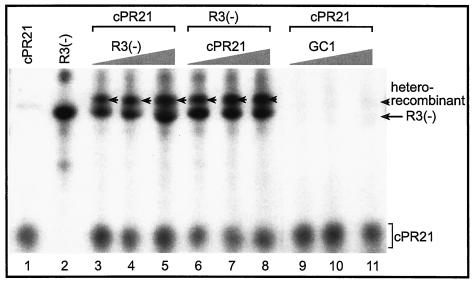FIG. 7.
A denaturing PAGE analysis of heterorecombinants generated with the CNV RdRp preparation. A chemically synthesized 21-mer RNA, called cPR21, which represents the very 3′-terminal promoter sequence in the minus-stranded TBSV (47), is used in combination with two other RNA templates (Fig. 1) as shown. The amounts of RNAs used for the CNV RdRp reactions were as follows: cPR21 and R3(−) were 300 and 45 pmol in lanes 1 and 2, respectively. The samples in lanes 3 to 5 contained 300 pmol of cPR21 and increasing amounts of R3(−) (15, 45, and 75 pmol, respectively); in lanes 6 to 8, the amount of R3(−) was fixed (45 pmol), while that of cPR21 increased progressively (100, 300, and 500 pmol, respectively). The samples in lanes 9 to 11 contained 300 pmol of cPR21 and increasing amounts of GC1 (15, 45, and 75 pmol, respectively). The heterorecombinants are marked with arrowheads. The long arrow indicates the de novo initiation products of R3(−). The GC1 RNA resulted in an almost-undetectable amount of de novo and recombinant-sized products. Note that the CNV RdRp preparation initiates de novo on these templates.

